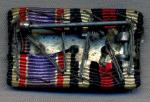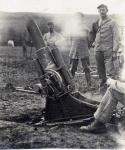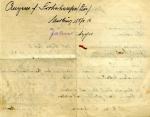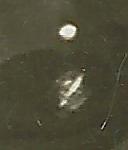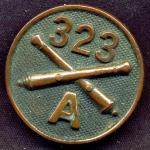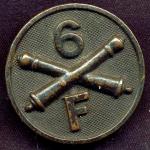-
Posts
5,629 -
Joined
-
Last visited
Content Type
Profiles
Forums
Blogs
Gallery
Events
Store
Everything posted by IrishGunner
-
Took your advice and scored this one just before Christmas... Appears to be training on the 17cm mittlerer Minenwerfer. On the reverse is written: "Ladehemmung eines mittleren Minenwerfers" If it really was a misfire, I think they wouldn't be taking pictures; thus, my conclusion it's training. Note the guy with the leather sleeve standing on the right.
-

Czechoslovakia Post-War I Czech?
IrishGunner replied to IrishGunner's topic in Central & Eastern European States
This is the best I could do of a badge... From the guy in the middle with the "rank". By the way, I wonder what rank this is.... It is similar to the "desiatnik ašpirant" in Post #22, but my guy has 3 pips. -

Czechoslovakia Post-War I Czech?
IrishGunner replied to IrishGunner's topic in Central & Eastern European States
I want to follow-up with some new scans of my photo in Post #2... These are at 1200dpi using a HP scanner (instead of my older Epson). They still aren't that clear, but maybe will be helpful somewhat. First, the reverse has no writing - other than the printed info: "Foto VYVOZIL, Turo, Sv. Martin" Martin is in Slovakia, near the Fatra mountains; so, that might be the town of the studio that took the photo. Using a magnifying glass, the collar badges look very similar to those associated with "mountain" units in the above posts. -

It's not about your sister......
IrishGunner replied to Chris Boonzaier's topic in The Great War 1914 to 1918
-
In general, I would agree with Peter. I'd put the "value" bottom end closer to $30-50 though for a run-of-the-mill, nothing special Victory. That's what I'd pay. Victory Medals are listed - and realistically "sell" - quite often in the $50-$70 range (but not to this collector of British Vics unless there is a premium reason). I agree with his factors affecting price; a Military Medal winner (a single Vic w/o the MM) or casualty push up the price. So, will an unusual rank or an officer above lieutenant. But I don't think it only has to be a "rare" unit. Irish regiments and Guards regiments get a premium (sometimes getting closer to $75-$100) because there is "higher" demand. Interestingly, I haven't seen Scottish regiments, other than Guards or Black Watch, push up the average price. I've been lucky and have snagged my Scottish Vics (including Black Watch) for the $30-$40 range. For an "unresearched, unknown" Highland Light Infantry, I'd be willing to pay in the $30-50 range; hoping for around $40 in the middle. I'd only go to the top end $50 for an NCO or a good Scottish name. For one like your's, however, I think the Gallipoli connection is a definitely a premium; if it's already researched and advertised with the MIC - I believe it would bring closer to $60-75. A round about way of saying, I think you have better than average Victory because of it's Gallipoli connection and would bring better than the average price.
-

Italy Italy - Artillery regiment medals
IrishGunner replied to IrishGunner's topic in Southern European & Balkan States
Thanks! We'd be happy to see anything Italian you'd like to share.... -
A Battery, 323rd Field Artillery... Raised as part of the draftee National Army 83rd Division in Aug/Sept 1917; most of the troops for the 323rd FA came from western Pennsylvania north of Pittsburgh on the Ohio border (83rd Div was mostly raised in Ohio). The 83rd Division did not see combat as a division; it was a depot and training headquarters in France. However, artillery is never held in reserve and and I happen to have the history of the 323rd FA. The regiment arrived in France in July 1918 and went to the front in September 1918 and fought in the Meuse-Argonne offensive, first with the 29th Division at Verdun, the 26th Division near Belleau Wood, and marched to Rhine with the 32nd Division. The 323rd then performed Occupation duty in the vicinity of Strassenhaus, just north of Koblenz.
-
6th Field Artillery... C Battery 6th FA as part of 1st Infantry Division is credited with firing the first American artillery round of WWI. Unfortunately, I don't have a disc for C Btry. F Battery I haven't researched yet...
-
That's really nice! Because with an entry into theater of war info - "2b on 7-2-15" ... (2b is the code for Gallipoli and 2 July 1915); We know now he entered the war at Gallipoli as part of 1/5th (City of Glagow) Battalion, HLI! A territorial force battalion. Here's the HLI info... 1/5th (City of Glasgow) Battalion August 1914 : at Garnethill, Glasgow. Part of HLI Brigade in Lowland Division. Moved on mobilisation to Dunfermline. 11 May 1915 : formation became 157th Brigade in 52nd (Lowland) Division. 26 May 1915 : sailed from Devonport for Gallipoli, going via Egypt (5-28 June) and Mudros (1 July), landing at Cape Helles on 3 July. 8 January 1916 : evacuated from Gallipoli to Mudros and arrived Egypt in February. 11 April 1918 : Division left Egypt, battalion arrived Marseilles 17 April for service on Western Front. No other HLI battalion fought at Gallipoli. Also entitled to War Medal and 1914-15 Star. Now an even better medal IMHO!
-
Paul, I invite you to take a look at the British Victory Medals topic in the GMIC Inter-Allied Victory Medals of the Great War forum. A wealth of information and links. Highland Light Infantry is a collectable regiment for those with a Scottish interest; recruited initially mainly around Glasgow. With this lower regimental number, Private Hugh Park is likely from that area. Description of his Medal Index Card shows he later transferred to the Machine Gun Corps (and his regimental number for that Corps). Description Medal card of: Park, Hugh; Private, Highland Light Infantry 2692; Private, Machine Gun Corps 56422.
-

Even Blackadder can cause a political rift
IrishGunner replied to Nick's topic in The Great War 1914 to 1918
Another interesting article; "The first casualty: truth" (please, note the domain) From the conclusion of the article: "The centenary of the First World War must not be a chauvinistic cavalcade but nor should it be a pacifist’s parade. We should hope for an open, honest debate about the multifaceted meanings of this war, the diversity of the experiences of those who fought in it, and what lessons we can draw from it today." I found this in the "posted comments" section at the bottom of the article Chris posted above; I encourage everyone to scroll down on the suggested articles and see what others are saying outside of GMIC. -

Even Blackadder can cause a political rift
IrishGunner replied to Nick's topic in The Great War 1914 to 1918
"The war was “plainly a just war”, says Gove, because of the German attitude towards expansionism. And we certainly couldn’t stand by while another country fancied a bit of expansionism. Luckily, the one thing that you can say about the British in the century before 1914, is that at no time did it consider expanding or taking over anywhere or swiping anything from abroad." Hmmm. I didn't know Gove was a "nom de Guerre" for Fritz Fischer... -

Even Blackadder can cause a political rift
IrishGunner replied to Nick's topic in The Great War 1914 to 1918
(Disclaimer: It's a joke. Jeez.) -
According to a British General Staff publication in February 1918, "Foot Artillery; Index to the German Forces in the Field", Fußartillerie-Regiment Nr. 25/I.Bataillon - with three batteries, including 1. Battarie, was in the Argonne Sector as of 2 Nov 1917. The battery reportedly had 4 15cm howitzers. My guess would be that the howitzers were 15cm schweres Feldhaubitze M13 That's about as much as I can give you... I'd try to find more about the 49. RD as the next step. Maybe the Prussian or Chip have some references that I do not have...they know quite a bit on the topic.
-
Now for finding Fußartillerie ... it's damn near impossible - most times - without some specific information. Fußartillerie Regiments provided general support fires for Corps and Army-level commands, as well as manned coastal and fortress Artillery. The study of the Fußartillerie can be quite frustrating; there were many re-organizations, units changed headquarters more frequently than their socks, and references are very inconsistent. A Corps initially had one or two associated regiments of Fußartillerie ; however, once the war began, the Fußartillerie no longer fought as regiments. Battalions were allocated individually and regimental staffs assumed duties as Corps Artillery commands. As the war progressed, heavy artillery units often remained in one sector and frequently changed its higher headquarters affiliation. Usually there were 8 or 9 batteries allocated to a quiet division sector, with twice that many in a division sector considered more active. Heavy batteries within a sector would come under control of the divisional Artillery commander; the heavy batteries would usually remain in place as divisions rotated throughout the front. So, Chris is correct regarding knowing his battalion; your doc says 1. Batterie - so, that was I. Bataillon - at least for starters. Based on the above, the battalion could have been an operational headquarters for several batteries from different regiments. You really need to know where his battery was to get a fix on him. And day to day, the battery could be under a different HQ; so, references - other than a regimental history - are not conclusive. In 1914, there were 20 active Fußartillerie regiments; so, 25. was a war-raised unit. In 1914, there were about 400 batteries of heavy artillery. With war-raised units, there were 2,250 Fußartillerie batteries by January 1918. In addition to regiments, a number of independent Fußartillerie batteries (numbered 101-150 and 200-800) and battalions (numbered from 21 upwards) were formed during the war. So, you can see how difficult it is to pin-point a Fußartillerie battery. It's only a guess right now (I have to pull out some books), but I figure 25. Fußartillerie was formed 1915-16. I have no idea - yet - of exactly when or where or under which HQ. I will have to again pull out the books. According to my decidedly "non-authoritative" sources, after the re-organization of early May, 1918, I believe the 25. Fußartillerie was divided as follows: Fußartillerie-Regiment Nr. 25/I.Bataillon - 49.RD Fußartillerie-Regiment Nr. 25/II.Bataillon - 111.ID Fußartillerie-Regiment Nr. 25/III.Bataillon - 84.ID That should put your guy somewhere around the 49. RD in June 1918 - maybe - based on the date of your doc, but I have nothing more specific on the 25. Fußartillerie. I don't even own an item to this regiment yet. At least it's a step for you from the starting line.
-
Ahh, the tangled and confusing web of Fußartillerie Let's deal with the horses and foot first. In the beginning, both artillery and horses were quite expensive. Money was spent on guns, not horses; that's why artillery is called the King of Battle; only rich kings could afford the expensive guns. And in the beginning, usually only officers rode horses. Many times in the cavalry, the officer had to provide his own horse; thus the cavalry having a large share of aristocracy. Artillery officers on the other hand were usually middle class origins; so, even they had problems getting horses. (Yea, I know, generalizations.) Artillery also was heavy and usually relegated to garrisons or for use in sieges (in the UK the heavy artillery was called "Garrison" artillery; in the US "Coast Artillery" - owing to its heavy guns and application); the idea of light horse-drawn artillery is really a mid to late 19th century innovation (although there were horse drawn artillery cases in the 17th and 18th century - these were rare exceptions in armies). So, the animals (including oxen) that were available to drag these heavy siege weapons about, were used just for that...to drag the heavy weapons...that is if they left the garrisons (or forts) in the first place. The gunners had to walk...by foot. And often had to help drag the guns. Therefore, Fußartillerie or Artillerie à pieds for the French. Feldartillerie on the other hand was light and horse drawn to be brought into battle quickly on the front line to support the infantry. Different size guns and different application. The guns were usually light enough that the gunners could ride on the gun and still be pulled by a team of horses. That's where you find the horses - again, predominantly in the mid to late 19th Century. Of course, even the heavy artillery - Fußartillerie - was horse drawn during the war and gunners rode the accompanying caissons, but the name dates from long before this change occured during the war. Later tractors come in to play for the heavy artillery (Fuss could also be called "heavy" or "schwere" artillery). While, Feld continued to be horse-drawn even into WW2.
-

It's not about your sister......
IrishGunner replied to Chris Boonzaier's topic in The Great War 1914 to 1918
Hey, why does your tree have more bananas than mine?




